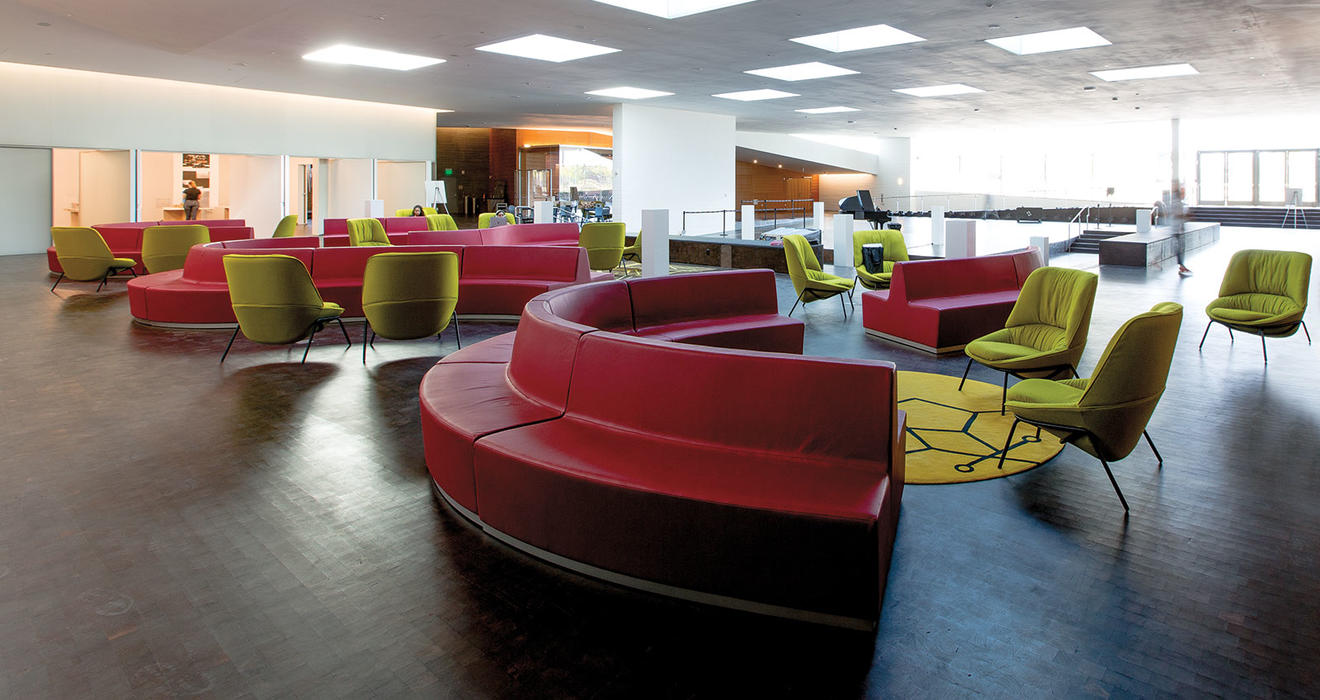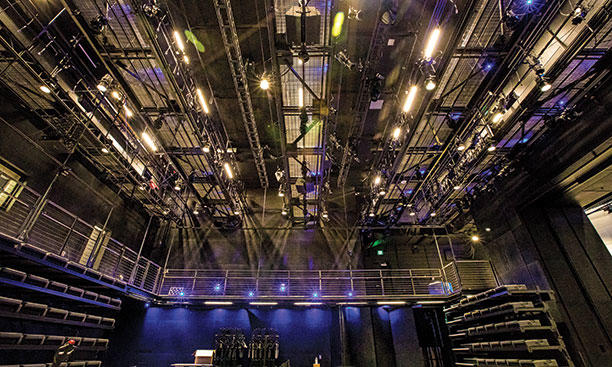
At a Princeton gathering in 2008, then-chair of the Lewis Center Paul Muldoon spoke about the transformative power of the arts. A chance encounter with art, he said, could change a person’s life.
Architect Steven Holl took Muldoon’s words to his drawing board. Walk down the path from Blair Hall to the new three-building Lewis Arts complex and you will be afforded a view through a glass wall into the music building’s two-story, 3,500-square-foot rehearsal room, where the 100-piece Princeton University Orchestra or a jazz ensemble may be practicing. Glance upward into the building’s second and third floors, and you may glimpse a pianist or a violinist in a teaching studio or practice room suspended from the roof by steel rods.
Stand in the complex’s defining feature, an 8,000-square-foot lobby called the Forum, which connects all three buildings. If the massive doors are thrown open, you can see into four performance spaces, perhaps getting a preview of a hip-hop dance rehearsal or an avant-garde theater piece. Look up to the mezzanine and you’ll get a peek at the latest sculpture or photography displayed in the visual-arts gallery. The transparent, translucent, and opaque materials used for the exteriors — a combination of stone and several types of glass — make the buildings glow at night.
The complex’s defining feature, an 8,000-square-foot underground lobby called the Forum (above), connects all three buildings. The skylights bring water-filtered light from a reflecting pool above into the space.
“These chance encounters can draw students in and transform their experience at Princeton,” says Noah Yaffe of Steven Holl Architects.
Located on the south edge of campus across from McCarter Theatre Center, the 146,000-square-foot complex is a major expansion of the facilities for the arts. The three structures — a music building, a dance and theater building, and a six-story tower — house the dance, music theater, theater, and atelier programs, as well as additional facilities for the music department.
The three buildings are arranged around a plaza with a reflecting pool and surrounded by landscaped plazas and green spaces. Nearby is the new Dinky station, a rebuilt Wawa, and two new restaurants, the Dinky Bar and Kitchen and the Cargot Brasserie, which are in the former train station and cargo-hold buildings. The entire project — known as the arts and transit neighborhood — cost $330 million.
Each building features the latest technology. The Wallace Dance Building and Theater, named after brothers Monte J. Wallace ’53 and Neil W. Wallace ’55, who contributed $15 million for the building, features a visually striking curved wall. The 3,600-square-foot Hearst Dance Theater has flexible seating for 120 that can be reconfigured in a variety of ways and a shock-absorbing sprung floor comparable to those in professional dance facilities. There are four studios built specifically for dance. The dance program never had a purpose-built studio before.
The 3,600-square-foot Wallace Theater, called a “black-box theater” because of its black walls, has flexible seating for up to 140 and features LED theatrical lighting. There are smaller studios for rehearsals and small performances, equipped with catwalks that give access to lighting and scenery. Many studios have video-recording equipment.
Several theaters in the complex have stages at least as big as the one at the Berlind Theatre at McCarter, so they can host rehearsals for a Berlind performance, something not found before on campus.
The 23,000-square-foot New Music Building supplements the existing Woolworth Center of Musical Studies at the center of campus, where the music department was bursting at the seams. Music performance, once primarily housed in the Woolworth basement in windowless rooms, “will come out of the depths and into this extraordinary new space, full of light and energy,” says Wendy Heller, the department chair. Here, as elsewhere in the complex, technology provides new opportunities. Musicians in the practice rooms and teaching studios have access to playback systems and audio-recording equipment. An acoustically isolated rehearsal room has equipment for making professional-quality audio recordings. (It also provides a place for the orchestra to rehearse, freeing up Richardson Auditorium for more performances by other groups.) New technology is not the only welcome addition in the complex: There are 48 new Steinway pianos.
The focal point of the arts complex is the Forum, below ground level, designed as a gathering place that serves as a physical connection among the different disciplines and encourages chance encounters and collaboration among artists. “It’s a place to congregate and socialize, and it will change how we interact with each other,” says Jane Cox, director of the theater program. Red leather serpentine couches can be reconfigured easily to provide spots for lounging and discussion. Above the Forum is a plaza with a 70-by-70-foot reflecting pool; skylights in the pool bring water-filtered light into the Forum. The Forum connects to the CoLab, a 75-seat space designated for interdisciplinary projects and multimedia presentations.
A six-story tower includes staff and faculty offices, a box office, a library, and an art gallery where work produced in the visual-arts program will be displayed. The program itself will remain at 185 Nassau St. (Parking for the complex is free in the West Garage on evenings and weekends. On weekdays, visitors can park free in Lot 20.)
For sustainability, all three buildings in the complex have green roofs covered with a variety of plants from the sedum genus to provide insulation. There are 140 geothermal wells—420 feet below ground—that connect to radiant piping and use moderate ground temperatures to provide heating and cooling for the buildings.
And appropriately for an arts complex, the area will showcase an important piece of outdoor art. Maya Lin, who designed the Vietnam Veterans Memorial in Washington, D.C., has been commissioned to create a work for the grounds adjacent to the center (as of mid-September, details were not available).
The complex, faced with glass and large stone panels, has a contemporary feel but also evokes continuity with the rest of the campus. The stone, similar in color to the stone in Nassau and Stanhope halls, comes from a quarry in Italy that has been active since Roman times. And the buildings form a three-sided courtyard, echoing other courtyards on campus. The courtyard, Muldoon emphasizes, has “three sides and no doors or gates. It says emphatically, ‘Come in.’”








No responses yet